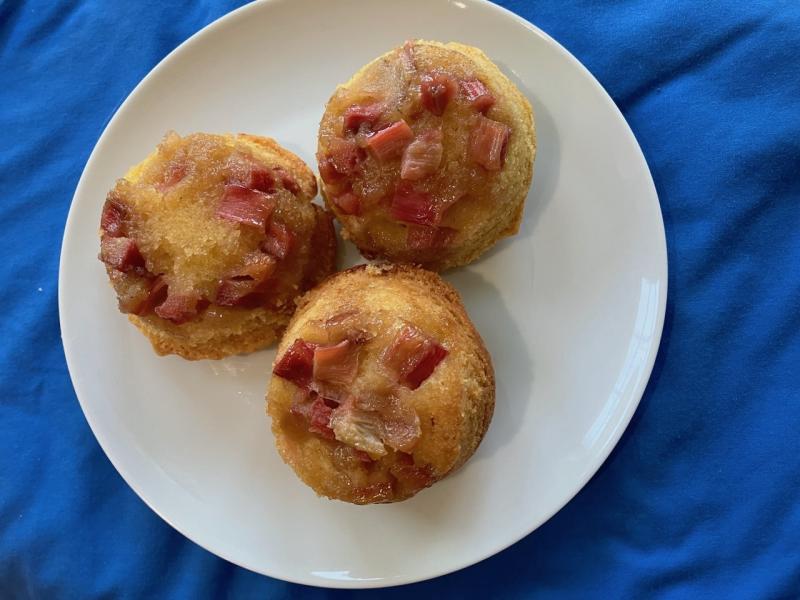Rhubarb - a vegetable that identifies as a fruit
One of the earliest vegetables to appear at the start of the growing season is rhubarb. With colorful stalks that closely resemble celery, rhubarb can be found in shades of light green to pink to deep red. While the stems are edible, the large, crinkled leaves are quite poisonous due to a high concentration of oxalic acid. The stalks, which grow from underground rhizomes, have been harvested for medicinal purposes for centuries. Although it’s botanically a vegetable, in the modern era, rhubarb has typically been treated as a fruit.
Wild rhubarb originated in Asia and thrived in the cold climate found in Mongolia, Siberia and the Himalayas. Writings from classical Greece and Rome describe rhubarb as a dried root traded by the Chinese. Rhubarb made its first appearance in England during the 16th century. According to botanist John Ray, rhubarb’s resemblance to sorrel inspired people to eat the stalks as food.
The original Latin name (Rheum rhabarbarum) comes from the Romans, who observed the plants growing along the banks of the river Rha (now called the Volga). Since that region was considered foreign or barbarian territory at the time, the name translates as “from the barbaric Rha.” Over the last few hundred years, rhubarb has become associated with cottage gardens and old-fashioned jams.
There are two types of rhubarb: hothouse-produced and field-grown. The former tends to be paler in color, the latter more tender in texture. During the spring, seek out brightly hued, cherry-red stalks with fresh-looking, blemish-free leaves. You’ll typically find the stalks sold separately, with most of the leaf material already removed. Since it is highly perishable, keep rhubarb tightly wrapped in a plastic bag under refrigeration, and be sure to use it within three days.
One of the key complaints about rhubarb is its intensely tart flavor profile, which explains why recipes usually include significant amounts of sugar and in some cases combine rhubarb with another sweet fruit. In the recipes here, we have a strawberry rhubarb crumble that combines sweetened fruit with a buttery topping of rolled oats. The rhubarb cupcakes are assembled like an upside-down cake, so the streusel topping starts on the bottom and becomes the top layer as the cupcakes are inverted.
The rhubarb compote can be used in a variety of ways. As it’s presented here in a savory form, it works as a sauce for grilled pork or roast chicken. If you eliminate the shallot and balsamic vinegar, you can use it as a sweet, colorful topping on a dish of vanilla ice cream. For other variations, consider some of the favorite flavorings that work well when combined with rhubarb, including ginger, nutmeg and cinnamon.
Strawberry Rhubarb Crumble*
6 C halved, hulled strawberries
4 1/2 C sliced rhubarb
1 C sugar
3 T cornstarch
1 T lemon juice
1 1/4 C rolled oats
3/4 C flour
3/4 C brown sugar
1 t cinnamon
1/4 t salt
12 T softened butter
Preheat oven to 425 F. Combine strawberries and rhubarb in a mixing bowl. Sprinkle with sugar, cornstarch and lemon juice. Stir gently to combine. Pour into shallow 3-quart baking dish; set aside. In a large mixing bowl, stir together oats, flour, brown sugar, cinnamon and salt. Using your fingers, blend in the softened butter until small clumps form. Scatter the topping evenly over the fruit in the baking dish. Bake until golden and bubbly, about 45 minutes. Serve warm. Yield: 8 servings. *Adapted from the Gourmet Cookbook.
Rhubarb Streusel Cupcakes
1/2 C brown sugar
1/4 C butter
1/4 t cinnamon
1 C diced rhubarb
1/2 C sugar
1/4 C softened butter
1 egg
1 1/3 C flour
2 t baking powder
1/2 t salt
1/4 t nutmeg
1/2 C cream
Preheat oven to 350 F. Generously coat the sides and bottoms of 12 muffin-tin cups with butter or nonstick cooking spray; set aside. In a mixing bowl, combine brown sugar and butter with a pastry blender until it resembles the texture of cornmeal. Stir in cinnamon and rhubarb, tossing to combine. Place a tablespoon of rhubarb streusel in the bottom of each muffin cup; set aside. In a large mixing bowl, cream together sugarand butter. Add egg and beat until smooth. Add remaining ingredients and beat thoroughly to form a thick batter. Distribute batter evenly across the muffin cups. Bake until golden, about 20 to 25 minutes. Allow muffins to cool for at least 5 minutes before inverting them onto a serving platter with the rhubarb streusel on top. Yield: 12 muffins.
Rhubarb Compote
2 C diced rhubarb
1/4 C sugar
1 t butter
1 chopped shallot
1 T balsamic vinegar
Combine rhubarb and sugar in a saucepan. Allow to stand at room temperature for the rhubarb to release some of its liquid, about 20 minutes. During that time, melt butter in a saucepan and sauté shallot with balsamic vinegar until tender, about 5 minutes; set aside. Bring the saucepan with rhubarb to a boil over medium heat, stirring constantly. Reduce heat to low, cover and cook until rhubarb is tender, about 10 minutes. Stir in shallot mixture and transfer to a sealed container. Refrigerate until the mixture thickens, about 2 hours. Serve as a sauce for grilled pork chops or roasted chicken. Yield: 3/4 C.
























































